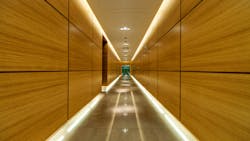Lighting controls are devices and systems that produce the right amount of light where and when it is needed, thereby supporting a broad range of visual needs and energy management objectives. Over the past two decades, as LEDs were revolutionizing illumination to much fanfare, lighting controls were experiencing a quieter but still significant evolution. Recent capabilities include independence from circuiting, wireless communication, smaller control zones, distribution of intelligence and control toward the luminaire layer, color tuning, integration with other devices and systems, and the installation of building-level lighting platforms capable of global control and programming and data analytics via graphical interfaces. As a result, the effectiveness of a lighting design is virtually inseparable from the effectiveness of its lighting controls design.
As with lighting, the “best” solution in lighting control is the one the designer selects as most appropriate for satisfying owner requirements. In terms of pure capabilities, however, a networked lighting control system is arguably the most robust option. This is an intelligent system in which addressable devices communicate to enact control strategies individually or in groups, with the potential for data generation.
Commonly, these systems are implemented at the room level, configured for an energy code–compliant sequence of operations. In certain applications, it can be advantageous to implement networked control at the building or campus level, as a skilled operator gains the ability to configure and change sequences of operation, monitor for lighting maintenance, and measure data such as occupancy and illumination. This supports a path to building systems integration, including the potential to convert data into value-added services, such as space optimization, which dramatically expands the value proposition.
A 2017 DesignLights Consortium study of 1,200 control zones in 114 commercial buildings found that networked lighting control systems saved 47% on average in lighting energy, thanks to their intelligence and responsiveness. Due to the high energy savings, numerous utility rebate programs now support the technology. These savings contribute to the traditional value proposition of minimizing energy costs. In some projects, however, the smaller LED load produces energy savings that may not justify the potential cost premium and complexity involved in a centralized approach even if all other conditions are optimal for installation.
The effectiveness of a lighting design is virtually inseparable from the effectiveness of its lighting controls design.
As a result, the conversation around the value proposition for centralized networked lighting controls is changing. With new capabilities such as color control and data analytics, the proposition has expanded to include supporting occupant wellbeing and improving operations and location-based services. The crux of change shifts the perspective of viewing light as a commodity — an ongoing cost that should be minimized — to viewing lighting as an asset, a tool that can produce organizational benefits that go beyond delivery of lumens.
In the end, these generalized benefits manifest in real-world applications. What could be done with greater control of lighting in my building? How is the control system operated to generate satisfactory energy savings while deriving other benefits specific to an owner’s applications? How could the data be used to benefit stakeholders in an organization?
To answer this question, I will explore three theoretical applications through which I will examine capabilities realized over a full year, while diving deep into building operations. Ultimately, I hope they provide a frame of reference for real-world conversations that redefine the conventional based on new capabilities.
Application 1: Hotel facilities manager
Mary is a facilities manager for an upscale urban hotel offering numerous amenities that define the guest experience and for which she is responsible for their environmental impact. A problem-solver, she regards advanced lighting control as an opportunity to monitor and manage lighting in the full range of space types and operating conditions, ensuring it is optimally contributing.
The new lighting control system features a network of devices set to automatic, scheduled, room-specific control functions that hotel staff can access, adjust, and override using touchscreens with custom GUIs in a secured room. From her tablet, Mary can do the same and more, such as adjusting scheduled control functions and fine-tuning illumination and color via lighting and window shade controls. She can also analyze space usage to address potential problems.
In the summer, the control system minimizes energy consumption by automatically adjusting illumination in response to daylight availability. During these bright days, Mary wants to ensure guests transition comfortably from high exterior to lower interior light levels. In vestibules and adjacent spaces, she sets the lighting to support eye adaptation. Otherwise, she tours the hotel regularly to ensure the system provides the ideal guest experience by using her tablet to adjust lighting and temperature in each space.
The crux of change shifts the perspective of viewing light as a commodity — an ongoing cost that should be minimized — to viewing lighting as an asset.
In the autumn, the hotel ballroom receives more bookings. The hotel staff can configure these spaces quickly using the centralized touchscreen controls. In the winter, the control system enacts a warmer color tone and lower intensity to produce a cozy visual experience. While this functionality is automatic, Mary again tours the hotel and adjusts as needed.
Meanwhile, she understands that perfectly functioning lighting contributes to the overall perception of the hotel. As a result, she sets her system to automatically notify her of malfunctioning lights and other devices for responsive maintenance. The system also provides an alert when lighting is reaching end of life and should be replaced.
Using the system software, Mary tracks which public spaces guests use and how frequently. She creates a heat map of traffic volumes and discovers one ballroom is used far less than the others. After some digging, she learns the ballroom’s windows overlook a new neighboring construction site and decides to switch the ballroom to temporary storage space until the construction completes.
Application 2: Building manager
John owns a commercial building. To ensure profitability, he wants to minimize costs while maximizing value for his tenants, some of which span multiple floors. Tenants are continually moving in and out of the building. He wants a flexible lighting control system to allow him to add and remove tenants when needed, while monitoring their energy consumption.
John’s lighting control solution consists of a series of networked intelligent control panels installed throughout the building. These panels connect to a central server in his office, where software enables him to select panels and analyze energy consumption for a particular tenant.
New tenants often move in during the summer. During this process, they can use these panels to install their own lighting and controls and potentially add new panels. As a result, tenants easily and quickly connect to the building’s lighting control network. When a tenant leaves, the panels remain connected but become inactive until a new tenant arrives.
As the weather becomes colder, the system monitors traffic at the front doors using occupancy sensors. This allows John to tune heating to support high-traffic periods, thus minimizing energy waste.
At the end of the year, the networked lighting control system has collected data on all tenants. John notices one is using far more energy than the others and discovers the tenant has disabled all daylight sensors. Digging further, he learns the sensors’ sensitivity was not properly calibrated, producing a lower brightness than specified. Recalibration solves the problem.
Meanwhile, because the system is connected to the power grid, John is able to monitor electricity costs by time of day and reduce energy consumption where possible during peak demand periods. The energy reduction is automatic though John defines what the system does during these peak times.
Application 3: Corporate chief financial officer
Janet is CFO for a national manufacturing enterprise with locations across the country that include office buildings, staff parking lots and garages, assembly facilities, and warehouses. Janet wants to minimize energy costs, maximize operating efficiency, and inform her decision-making with comprehensive information. She wants a lighting management solution that can control different building types with specific profiles and collect data so she can track occupancy and energy consumption from her office. With this data, Janet can evaluate the utilization and efficiency of each building and make good decisions.
Her enterprise’s networked lighting control system connects to the internet, allowing the facilities team to view and control lighting at every location. This solution places a central server at each building, which in turn connects to its network of devices. Each server and connected network operate autonomously, though the facilities team can alter and fine-tune control profiles from a central location. The granularity of data can be increased by increasing sensor density in each building. Janet can also have new buildings added to the system and duplicate control profiles from one building to the next.
In the summer, the facilities team analyzes data collected from daylight sensors and dimmer switches in warehouses to determine whether and how much electric lighting is needed during sunny days. They discover that due to skylights in the warehouses, they can reduce daylight response setpoints during sunny conditions without affecting productivity. Other adjustments and tuning follow.
Meanwhile, a large number of the enterprise’s employees work in open office environments with shared lighting, but the facilities team proposes providing them individual control of lighting mounted directly over their workstations. With the networked control system, users are provided dimmer remotes that control their overhead lighting, which contribute to their satisfaction and save energy.
The control system also generates data showing which spaces are currently in use along with historical data profiling space utilization. Using this information, the facilities team can adjust space use to optimize utilization and plan renovations.
Janet’s effectiveness in her role is highly dependent on the accessibility of quality information, and by the end of the year, she has a great deal of it at her fingertips. Her user interface provides an easy way to present it to her CEO, board, and investors. She is able to demonstrate how much energy the enterprise has saved and project future savings based on proposed decisions.
What can networked lighting control systems do for you?
These other examples illustrate what centralized networked lighting control systems can do for decisionmakers and their building occupants over the course of a year. I hopes this fuels inspiration that can take conversations about networked control beyond energy savings to its full range of potential use cases and benefits.
A version of this article by the author was published on the Lighting Controls Association website in November 2021.
CRAIG DILOUIE, LC, CLCP, is education director for the Lighting Controls Association, a council of the National Electrical Manufacturers Association dedicated to educating the public about lighting control technology and application. Learn more at lightingcontrolsassociation.org.
For up-to-the-minute LED and SSL updates, follow us on Twitter. You’ll find curated content and commentary, as well as information on industry events, webcasts, and surveys on our LinkedIn page and our Facebook page.









